Beyond the Corporate Office: The New Landscape of Work and Workplace
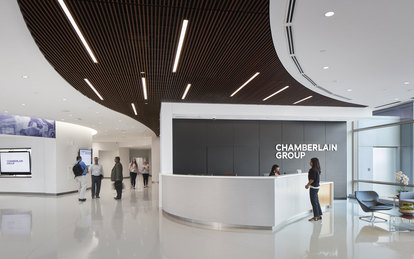
This article, co-authored by George Athens of SmithGroup, was originally published in Work Design Magazine in October of 2018.
The corporate workplace was traditionally the primary place where work—in its many forms—was conducted. It also represented the brand and image of an enterprise and had the promise of both representing and enabling the culture of that organization.
If we are to understand the motivations driving the creation of new places of work, we must also understand that the nature of the traditional organization has changed dramatically in recent years. Advances in technology and shifting attitudes among consumers are altering the purpose of organizations, as well as the bonds that hold them together. Additionally, in our highly-connected world, populations and workers are becoming increasingly mobile. The combination of these and a myriad of other factors present challenges, as well as opportunities.
Historically, the organizations we created were served by structures put in place to facilitate the communication of ideas and control a wide range of activities from the top down. Intellectual property was controlled by a select few, and mechanisms of delivery were designed for the efficient communication of commands down the pyramid to the levels where products—regardless of whether they were physical or services—were created. Workers at the lower levels of an organization—those closest to final creation—were selected and engaged primarily based upon their ability to ensure efficient and precise execution of orders. Once a big idea came to life, work for most people became rote, repetitive, and centered on executing someone else’s commands. Employees were there to serve the purpose of the organization—and were rewarded in the form of a paycheck, which helped to serve their personal needs.
For most, work stopped once outside of the physical boundaries of an organization. And those physical environments weren’t intended to inspire. Rather, they were considered unavoidable costs to a business—something that needed to be contained. Additionally, design considerations for these places addressed only a handful of factors: the efficiency of physical movement, the utilization of space, and the containment of the cost of production. Physical proximity with those whom you worked with was critical, as communication with co-workers was limited to face-to-face exchanges. Moreover, the nature of the work focused on efficiency and precise repetition of process. Efficiency and achieving economies of scale were critical to driving down the cost of operation and, in turn, increasing profits.
As a result, innovation was incremental and driven at a slow pace by economic forces that played out over years—sometimes decades—and were more-or-less confined to the country of operation. Companies did not feel global pressure in the way they do today.
THE ORIGIN OF THE CORPORATE WORKPLACE
The origins of what we know to be the corporate workplace came to be during a post-World War II corporate headquarters building boom beginning in the 1950s and extending into the first part of the 1960s. It was epitomized by the classic corporate architecture of SOM’s Union Carbide Headquarters in New York City; Eero Saarinen’s John Deere Headquarters in Moline, Illinois; SOM’S Lever House in New York City; Saarinen’s IBM Research Facility in Rochester, Minnesota; and Connecticut General Life Insurance Company Headquarters by SOM.
One could go back to Frank Lloyd Wright’s Johnson Wax Headquarters, too, but it was the period between 1954 and 1964 that witnessed the great expanse of corporate office buildings being constructed and within it the corporate workplace. Together, these works created the foundation of a single entity or suburban campus as the symbol of the organizations that they came to represent and at the same time served to define the corporate office.
While, in many instances, we have moved away from the rigid, sterile workplace solutions contained within those structures and migrated from private office environments to open office environments supporting activity-based and agile work, the purpose, function and symbolism of the corporate office has maintained its role.
The current corporate headquarters of Google, Apple and Facebook, while differing stylistically from their forebearers five decades ago, still serve the same purpose. It’s somewhat ironic and of note that these latter organizations, which have served to disrupt multitudes of industries and will be discussed in greater detail later in this piece, have taken on, in many respects, notions around the significance, symbolism and presence of the corporate office.
Despite this somewhat ironic phenomenon, those very same technology-driven organizations have disrupted many industries around the world. Such disruption has not only changed the nature of what many businesses do. It has also caused companies the world over to revamp their organizational design to match new business models, to change what work is, and to redefine what professions are.
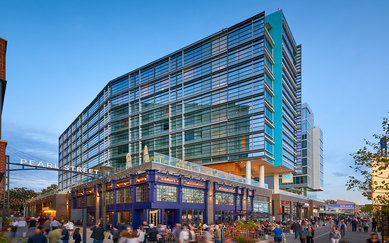
The District Wharf, Washington, DC.
Additionally, our highly connected world—where we can engage with people and ideas around the globe—has liberated us from the constraints of the physical office environments we previously described. Today, work and life are more mobile and portable. The infrastructure of the internet has expanded our exposure to people and ideas. This new connectedness has led to the erosion of the boundaries that once defined our lives—and is inspiring the reformulation of a new and exciting reality. In this new paradigm, work is conducted in coffee shops, co-working spaces, at home, even in outdoor spaces.
DISRUPTION: THE NEW NORM
Disruption and change are not limited to the workplace. Societies around the world are confronting increasingly complex challenges, including environmental degradation, eroding standard of living and well-being, and challenges of competition resulting from an increasingly global economy. Disruption in business models, as well as the ways in which companies remain relevant, has become the existential challenge of today. For many organizations, the need to build engines of innovation that are agile and fast to respond to market forces has replaced efficiency as the concern of paramount importance. As a result, companies and organizations are grappling with how to leverage their investment in people.
On the organizational scale, many manufacturing organizations are no longer in the business of manufacturing a product. Take the automobile industry. Ford Motor Company and General Motors have evolved from the business of producing automobiles into the mobility business—which many consider a technology organization of sorts. IBM went from being the symbol of computers to being a technology consulting organization, having had their business model disrupted by Apple. The world of retail has been disrupted by Amazon, which is pushing brick-and-mortar organizations like Walmart to change their business model.
Such disruptions are not limited to the corporate and retail sectors. The recent coming together of JPMorgan, Amazon and Berkshire Hathaway to form an alliance to develop models for the delivery of healthcare services has the real potential of disrupting that same healthcare industry, which has already seen changes as CVS and Walgreens has started to provide walk-in medical services.
But these changes only scratch the surface. The technology platforms that are available paved the way for the ‘sharing economy’ and the rise of Uber, Airbnb, and co-working – all of which have capitalized on technology to disrupt and change how services are provided to consumers. A result of this is a significant change in the perception and need to move beyond proprietary ‘space.’
In this new reality, we share space in automobiles that are run by individuals we do not know, yet still have a comfortable feeling of security. We rent homes for vacation from strangers that are not linked to hotels. More importantly, and what we believe is and will have the greatest impact on changing the role of the corporate office, is the intended and unintended consequences of co-working spaces: the profound change in thinking about the need for and the benefits of connecting and sharing knowledge with individuals and organizations beyond ones’ own enterprise.
There are undeniable benefits and disruptions resulting from co-working through creating office space that is immediately ready for occupancy, that can be downsized or enlarged at will, and in which costly amenities such as conference centers and cafes are available to all. Some speculate that the notion and comfort around greater engagement across corporate borders will have the greatest impact on defining what the workplace looks like and where work is conducted. The result is that the ease and comfort represented by the sharing economy is creating the expectation and need for blurring the lines and boundaries between where we work, live, shop and go for entertainment and recreation.
The ever-present need for organizations to create environments that foster innovation within their businesses, to be successful, and to stay ahead of the next disruption is now fusing connections across boundaries. And it is increasingly accepted that the climate enabling innovation is created through serendipitous interactions—the coming together of what Roger Martin, the Dean of the Rottman School of Business at the University of Toronto refers to as opposable minds—and the merging of once independent areas such as corporate and education. An example of such collaboration can be seen at Cornell University’s Tech Campus on New York’s Roosevelt Island. Here, a partnership with the Bloomberg organization illustrates the benefits that arise when business and higher education entities form alliances for the explicit mission of enabling innovation.
The emergence of so-called smart precincts or innovation hubs is the convergence of work, shopping, living and entertainment all contained within and fueling off the energy of the urban experience. This coming together should not be confused with what has traditionally be termed ‘mixed-use.’ A specific mission and strategy are informing this new convergence—and it is the natural progression of co-working on an urban scale. Mirvac, a leading integrated real estate group, has partnered with the Worktech Academy to create “The Future of the Smart Precinct” that connects the experience economy, the sharing economy, work-life blend, and workspace in the form of service, transportation, living, retail and hospitality—all connected with public spaces that afford both serendipity and opposable minds. These are the prime ingredients for innovation.
What needs to be overlaid on these significant shifts are the merging of three forces: the future of work will result in the transformation in the way that the expertise of professionals is made available in society (Richard and Daniel Susskind; The Future of the Professions; 2015); the fact that by 2050, 68 percent of the world’s population will reside in cities and urban environments (Agile Cities: Preparing for the Fourth Industrial Revolution; World Economic Forum; 2018); and the fact that 65 percent of students starting elementary school today will work in jobs that do not currently exist (World Economic Forum; 2018).
To understand this new landscape of work, and the elimination of the corporate office, we need to view and understand all these influences in concert and not as isolated elements. The convergence of shifting expectations resulting from the sharing economy; the blurring of boundaries between work, retail, living, and hospitality; and the startling realities of new forms of professions yet to be created and existing within the urban context are all pointing towards the continued erosion of the traditional concept of the corporate workplace and the emergence of a new landscape of work—one not contained within traditional boundaries of either the commercial office building or the corporate headquarters.
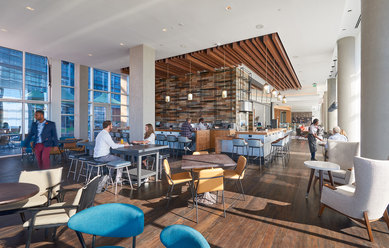
CONVERGING LANDSCAPES
In a recent report from ISS Facilities Services, it is noted that the emergence of smart cities will foster and enable the traditional workplace to extend its realm beyond the containment of the office building. This will further enable and support what we are referring to as a new landscape of work. We are witnessing the convergence of multiple so-call landscapes that previously were viewed as independent entities, though existing often in some form of alignment. The notion around the merging of where one works, lives, shops and goes for entertainment is no longer an ideal around mixed-use—it is the convergence of these entities as a unified whole to be determined strategically in a cohesive and strategic manner. Further, we see this convergence model as extending beyond this realm with the inclusion of smart precincts made up of universities, healthcare, and hospitality facilities, all seeking the benefits of the interactions that are afforded within this new landscape. A vivid example of this convergence is the Circle Development at the Zurich Airport in Zurich, Switzerland. It is a convergent development that is comprised of workspaces, retail, hospitality, healthcare and learning, all connected to and merging with Zurich’s airport.
The last element to consider that is also a consequence of the culture created by the shared economy is a convergence of adaptability, permeability and agency, or the need and desire of individuals and organizations to control and change their environments. Smart technologies--either within the office or the city—create possibilities for greater ability to change environments. For example, one of the benefits of co-working enterprises is that they allow organizations to change their real estate and work portfolio at will. In addition to affording flexibility, this also represents greater control over one’s destiny—or at least one’s options.
An important off-shoot of this and the sharing economy is the perception and desire for greater control (or agency) over one’s life, whether that be individually or organizationally. This is represented in the form of hackable architecture. This notion around hackability (see Carlo Ratti’s “Open Source Architecture” and “The City of Tomorrow”) allows individuals and organizations to change their environments quickly to support and reflect the continued organizational changes required in what is also a new landscape of the work and the organizational environment.
REDEFINING THE CORPORATE OFFICE: THE NEW LANDSCAPE OF WORK IN THREE SCALES
This new landscape of work will be played out in three scales, blurring and merging into a convergent work environment. These three scales are the workspace, the building, and the urban context. What they all have in common is that the previous view of these entities as isolated and singular will be replaced as three scales of campuses: the workspace as a campus, the office building as a vertical or horizontal campus, and the city as the urban campus—the place that contains and connects these varied components and enlivens them with the fabric and vitality that cities offer.
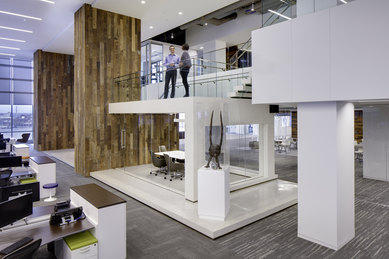
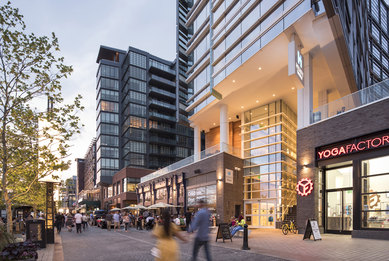
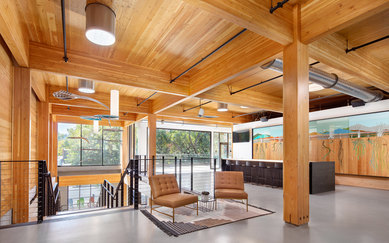
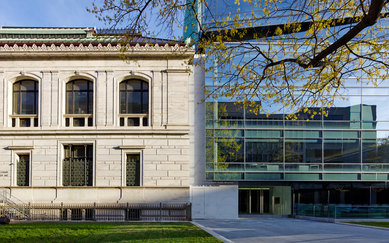
At the work space scale, floor plates need to be able to allow for greater variety of typologies and the ability to enable and allow for change and permeability. This means floor plates that are deeper and with greater column spacing will become the norm. The floor plate with the center core that was designed for a world occupied as in Mad Men—where private office ringed the perimeter and the open office were reserved for administrative functions—no longer exists or is sustainable as a building type.
With the advent of this new landscape of work—where individuals will have greater flexibility and choice in selecting where they work based on individual work styles and team requirements—the so-called home office, formerly the corporate office, will change in role, in function and ultimately, in size.
If one’s work environment now includes spaces that are outside the physical boundaries of the corporate office, this space will change its function as being the place where employees come to socially interact, engage and collaborate with colleagues. This will radically change the function of the corporate or home work space and, at the same time, reduce the amount of space requited to house employees.
At the building scale, the role of the commercial office building will also change. Rather than serve as a container of individual organizational enterprises, the commercial office building will be a place that allows for greater interaction between individual entities by creating shared spaces throughout the building, not just on the ground floor or lower levels. With the increased focus on cities as the primary places where people will live and work, office buildings—whether they be for single occupants or multiple tenants—will become vertical campuses, allowing for and facilitating interactions and movements vertically. In this environment, they will function much the same as the university campus, with the exception that they will be linked with shared opportunities for interaction at multiple levels.
The urban context will be transformed as a campus that knits together these various entities and creates greater opportunities for both individual and collaborative activities. This will allow individuals to work in a variety of settings, intermix, and blur the boundaries between work, living and entertainment. The urban environment will become the new corporate workplace and will be the component that serves to link varies entities in a manner that allows for serendipity, interest and surprise.
CONCLUSION
Just as technology has enabled the shared economy to arise and be successful, the cultural shift that the sharing economy represents is enabling and creating the need and requirement to create a convergent work landscape. The greatest challenge to this will be the ability or inability of organizations to modify and reinvent their business and organizational models to align with a convergent world. This is not to be underplayed. While we all enjoy the vision of an agile, engaging work environment, these new work environments that we see published are not how most work places exist today. We are confident that this vision of a new landscape of work will replace our current view of the corporate workplace. The speed in which this will occur will not be determined by the success or availability of technology. Instead, it will be by the ability of organizations to face this new reality, envision it as a tool to support the innovative thinking they will need to live by, and make the necessary organizational design changes that will either enable them to build off of the disruptions resulting from emerging businesses and disruptors, or fail and become one more entity in the text books of organizations that were not facile enough to adapt.